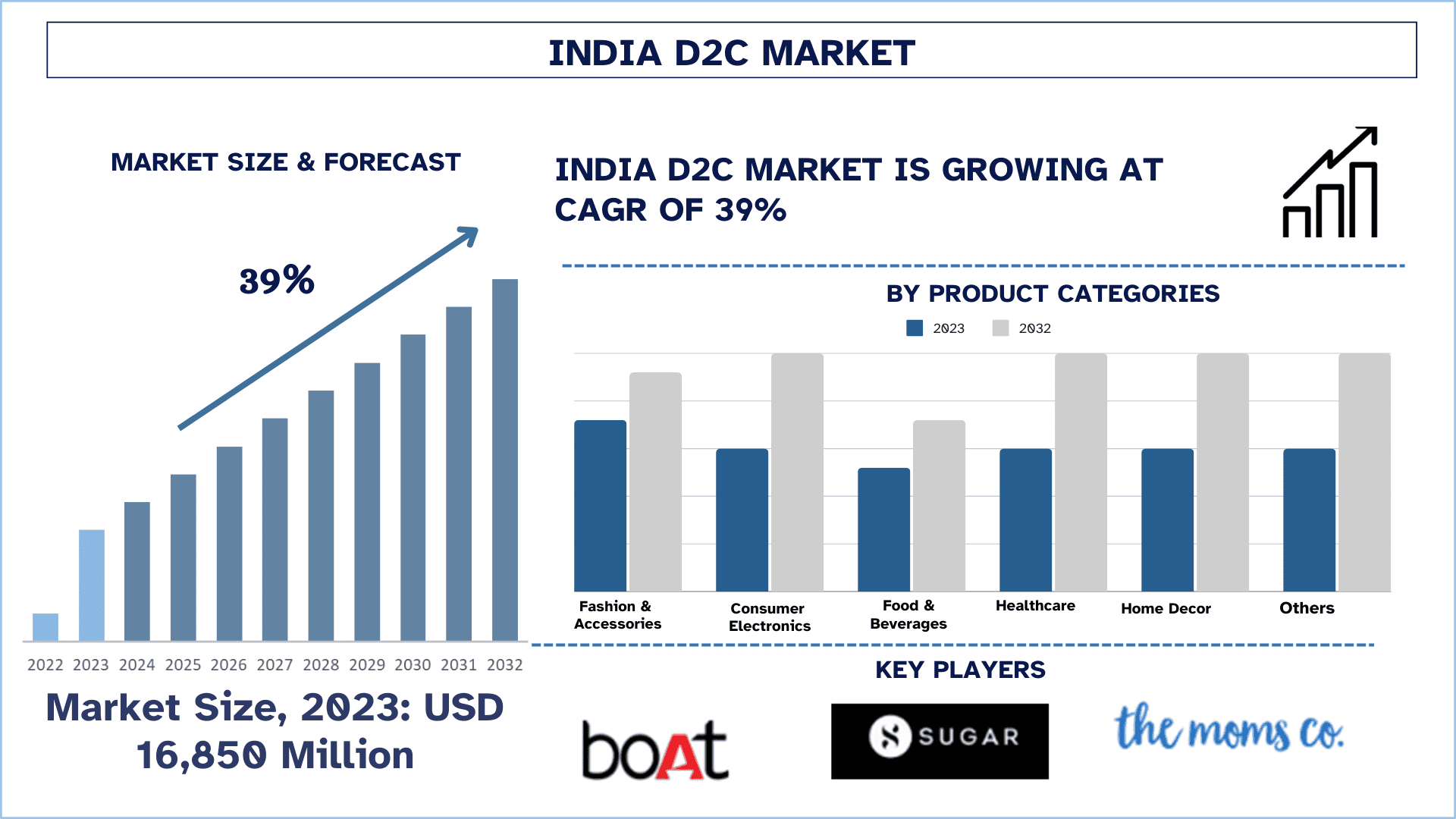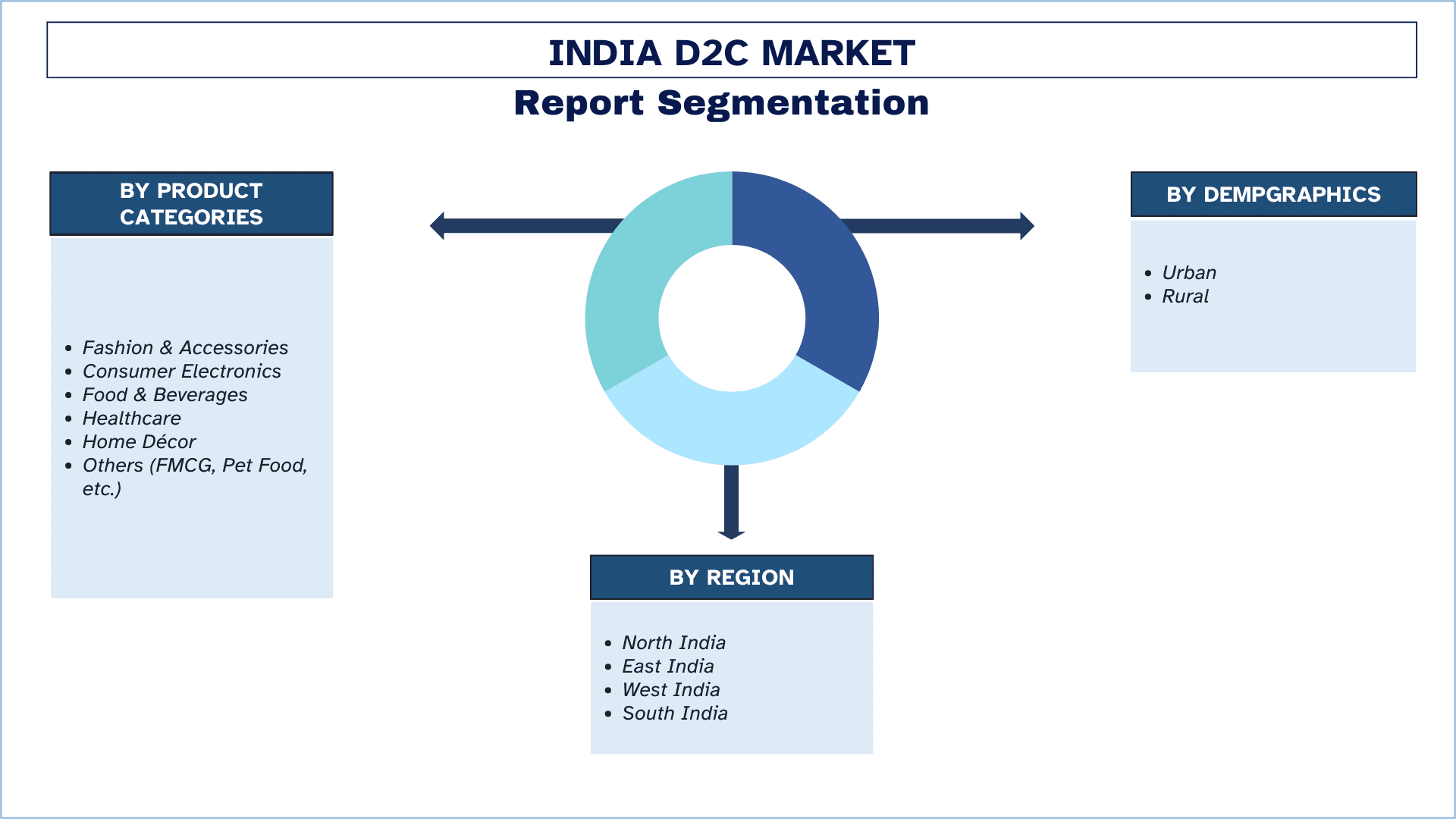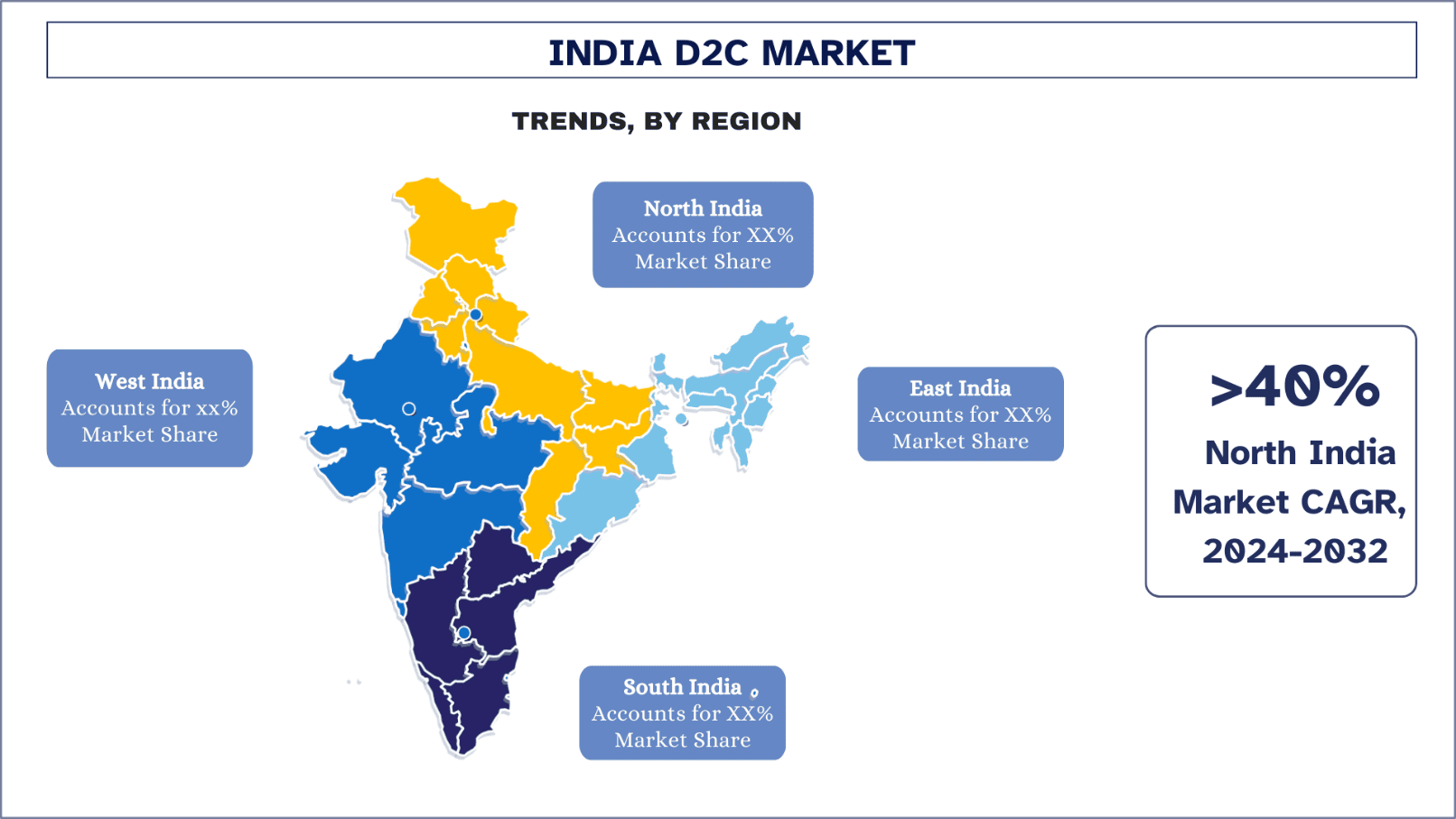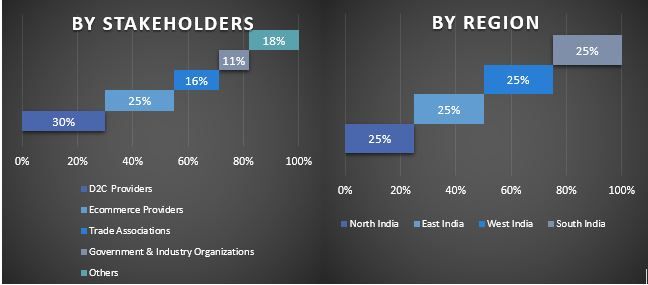Emphasis on By Product Categories (Fashion & Accessories, Consumer Electronics, Food & Beverages, Healthcare, Home Décor and others); By Demographics (Urban, Rural), and Regions (North India, East India, West India and South India)

The India D2C Market was valued at USD 16,850 million in 2023 and is expected to grow at a strong CAGR of around 39% during the forecast period (2024-2032) owing to rising purchasing power and increasing internet penetration in India.
India Direct to Consumer market has witnessed a rapid growth in the historical years. As per the higher growth of internet using population as well as increasing inclination towards online purchase with the ease of payment modes such as Paytm, Phone Pay, Google Pay, and other digital wallets and other card based online transactions the D2C market has majorly benefited. Furthermore, many of the leading D2C companies have also listed them on other major ecommerce sites such as Flipkart, Amazon, etc., apart from their company websites which has increased their presence and supply network.
The India D2C market was valued at USD 16850 million in 2023 and is expected to grow at a strong CAGR of around 39% during the forecast period (2024-2032). As per the higher growth of internet using population as well as increasing inclination towards online purchase with the ease of payment modes such as Paytm, Phone Pay, Google Pay, and other digital wallets and other card based online transactions the D2C market has majorly benefited. Furthermore, many of the leading D2C companies have also listed them on other major ecommerce sites such as Flipkart, Amazon, etc., apart from their company websites which has increased their presence and supply network.
Additionally, the growth of ecommerce has substantially supported the D2C business across the country as companies have gained major prominence through these channels. Ecommerce websites as Amazon, Flipkart, Myntra, etc., provide wide variety of products and offer wide range of offers through payment solutions with discounts. Additionally, the speedy delivery process of the products to pan India has also benefitted the companies to expand their reach to a wide number of customers. Furthermore, the emergence of quick commerce services in Tier-1 and Tier-2 cities have also provided ample push to the D2C companies as quick delivery in 10-20 minutes of electronic goods, apparel, healthcare product, pet products, etc., expand the sales of the companies.
Considering all the major changes in the country the demand for D2C is further anticipated to rise during the forecasted years. As the number of customers using internet of product purchase and making purchase decisions through social media marketing and availing speedy delivery of goods in lucrative pricing the D2C companies would emerge as key market participants in consumer goods category in India further translating into the growth of D2C market in India during 2024-2032.
This section discusses the key market trends that are influencing the various segments of the India D2C Market as identified by our team of research experts.
Sustainability and ethical consumption are emerging as key demand creators within consumer behavior in developing countries such as India, which were primarily concerned with environmental and social issues. Consumers are increasingly getting aware of the fact that they influence the planet with their purchases and also started preferring to purchase from the brands that act responsibly in terms of eco-friendly practices, ethical sourcing, and fair labor standards. This attitude can be felt in the increased demand for things such as organic clothes, zero-waste package products, and cruelty-free cosmetics.
D2C businesses have, in a full-blown manner, tapped this arena with sustainability at the core of their business models. They are educating and conveying to the customers about the brands in order to align with consumers' values in growing their brand loyalty, such as transparency, ethical production, and environmental accountability.
The increased attention on climate change, pollution, and fast-depleting resources brings the trend of consumers giving a little more for products pertaining to the ethical and sustainability considerations. This trend creates a greater ground for differentiation by businesses and targets a more conscious, value-based market segment.

The growing DTC or direct-to-consumer market in North India is attributed to wide number of factors, including increased Internet penetration, migration of consumers from physical stores to online shopping interfaces, and ever-changing consumer preferences. Many of the cities such as Chandigarh, Jaipur, and Lucknow, New Delhi, Gurugram, Noida, etc., have attracted quite a number of D2C brands across multiple categories such as fashion, electronics, food and beverages, and home decor.
This convenience to young, tech-savvy people is likely to be a driving factor in the overall acceptance of D2C models. Increasing smartphone use and digital payments have made online shopping easy and accessible. Increased disposable income in the evolving middle class of North India has also stimulated demand for premium and niche products.
Speaking of influencers, D2C brands from North India capitalize on social media and influencer marketing to create brand awareness for their products and to connect with the audience directly instead of going through the conventional retail way to build a strong relationship with their consumers.

The India D2C market is competitive and fragmented, with the presence of several Indian market players. The key players are adopting different growth strategies to enhance their market presence, such as partnerships, agreements, collaborations, new product launches, geographical expansions, and mergers and acquisitions. Some of the major players operating in the market are Imagine Marketing Limited (Boat Lifestyle), Honasa Consumer Limited (Mamaearth), SUGAR Cosmetics, Wakefit, Amishi Consumer Technologies Pvt Ltd. (The Mom Co.), Delightful Gourmet Pvt Ltd. (Licious), Earth Paws Pvt Ltd. (Heads Up for Tail), URBAN LADDER, Zivame, and Bombay Shaving Company.
Details | |
Base year | 2023 |
Forecast period | 2024-2032 |
Growth momentum | Accelerate at a CAGR of 39% |
Market size 2023 | USD 16850 million |
Regional analysis | North India, East India, West India, and South India |
Companies profiled | Imagine Marketing Limited (Boat Lifestyle), Honasa Consumer Limited (Mamaearth), SUGAR Cosmetics, Wakefit, Amishi Consumer Technologies Pvt Ltd. (The Mom Co.), Delightful Gourmet Pvt Ltd. (Licious), Earth Paws Pvt Ltd. (Heads Up for Tail), URBAN LADDER, Zivame, and Bombay Shaving Company. |
Report Scope | Market Trends, Drivers, and Restraints; Revenue Estimation and Forecast; Segmentation Analysis; Demand and Supply Side Analysis; Competitive Landscape; Company Profiling |
Segments Covered | By Product Categories and By Demographics, By Region/Country |
The India D2C market can further be customized as per the requirement or any other market segment. Besides this, UMI understands that you may have your own business needs; hence, feel free to connect with us to get a report that completely suits your requirements.
1. Market Introduction
2. Research Methodology or Assumption
3. Executive Summary
4. Market Dynamics
5. Pricing Analysis
6. India D2C Market Revenue (USD Mn), 2022-2032F
7. Market Insights By Product Categories
8. Market Insights By Demographic
9. Market Insights By Region
10. Value Chain Analysis
11. Competitive Landscape
12. Company Profiled
13. Acronyms & Assumption
Acronyms & Assumption
14. Annexure
Annexure
Analyzing the historical market, estimating the current market, and forecasting the future market of the India D2C market were the three major steps undertaken to create and analyze the adoption of India D2C in major regions in India. Exhaustive secondary research was conducted to collect the historical market numbers and estimate the current market size. Secondly, to validate these insights, numerous findings and assumptions were taken into consideration. Moreover, exhaustive primary interviews were also conducted with industry experts across the value chain of the India D2C market. Post assumption and validation of market numbers through primary interviews, we employed a top-down/bottom-up approach to forecasting the complete market size. Thereafter, market breakdown and data triangulation methods were adopted to estimate and analyze the market size of segments and sub-segments of the industry. Detailed methodology is explained below:
Step 1: In-Depth Study of Secondary Sources:
A detailed secondary study was conducted to obtain the historical market size of the India D2C market through company internal sources such as annual reports & financial statements, performance presentations, press releases, etc., and external sources including journals, news & articles, government publications, competitor publications, sector reports, third-party database, and other credible publications.
Step 2: Market Segmentation:
After obtaining the historical market size of the India D2C market, we conducted a detailed secondary analysis to gather historical market insights and share for different segments & sub-segments for major regions. Major segments are included in the report as By Product Categories and By Demographics. Further regional/country-level analyses were conducted to evaluate the overall adoption of testing models in that region.
Step 3: Factor Analysis:
After acquiring the historical market size of different segments and sub-segments, we conducted a detailed factor analysis to estimate the current market size of the India D2C market. Further, we conducted factor analysis using dependent and independent variables such as By Product Categories and By Demographics in the India D2C market. A thorough analysis was conducted for demand and supply-side scenarios considering top partnerships, mergers and acquisitions, business expansion, and product launches in the India D2C market sector across the country.
Current Market Sizing: Based on actionable insights from the above 3 steps, we arrived at the current market size, key players in the India D2C market, and market shares of the segments. All the required percentage shares split and market breakdowns were determined using the above-mentioned secondary approach and verified through primary interviews.
Estimation & Forecasting: For market estimation and forecast, weights were assigned to different factors, including drivers & trends, restraints, and opportunities available for the stakeholders. After analyzing these factors, relevant forecasting techniques, i.e., the top-down/bottom-up approach, were applied to arrive at the market forecast for 2032 for different segments and sub-segments across the major markets in India. The research methodology adopted to estimate the market size encompasses:
Primary Research: In-depth interviews were conducted with the Key Opinion Leaders (KOLs), including Top Level Executives (CXO/VPs, Sales Head, Marketing Head, Operational Head, Regional Head, Country Head, etc.) across major regions. Primary findings were then summarized, and statistical analysis was performed to prove the stated hypothesis. Inputs from primary research were consolidated with secondary findings, hence turning information into actionable insights.

The data triangulation technique was employed to complete the overall market estimation and to arrive at precise statistical numbers for each segment and sub-segment of the India D2C market. Data was split into several segments and sub-segments after studying various parameters and trends By Product Categories and By Demographics in the India D2C market.
The current & future market trends of the India D2C market were pinpointed in the study. Investors can gain strategic insights to base their discretion for investments on the qualitative and quantitative analysis performed in the study. Current and future market trends determined the overall attractiveness of the market at a regional level, providing a platform for the industrial participant to exploit the untapped market to benefit from a first-mover advantage. Other quantitative goals of the studies include:
Q1: What is the current market size and growth potential of the India D2C market?
The India D2C market was valued at USD 16850 Million in 2023 and is expected to grow at a CAGR of 39% during the forecast period (2024-2032).
Q2: What is the driving factor for the growth of the India D2C market?
Growing Urbanization and internet penetration are some of the key driving factors for growth.
Q3: Which segment has the largest share of the India D2C market by Product Categories?
The Fashion and Accessories segment has the largest share of the India D2C market by product categories.
Q4: Which region will dominate the India D2C market?
North India is expected to dominate the market during the forecast period.
Customers who bought this item also bought